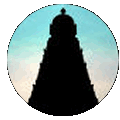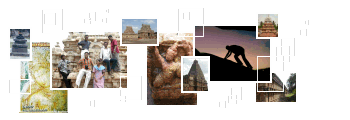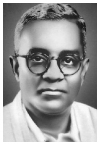 |
 |
 |
http://www.varalaaru.com A Monthly Web Magazine for South Asian History [187 Issues] [1839 Articles] |
 |
 |
 |
http://www.varalaaru.com A Monthly Web Magazine for South Asian History [187 Issues] [1839 Articles] |
|
Issue No. 49

இதழ் 49 [ ஜூலை 16 - ஆகஸ்ட் 17, 2008 ] 
இந்த இதழில்.. In this Issue.. 
|
திரு. ஐராவதம் மகாதேவன் அவர்களின் Felicitation Volume இன் 'மகாதேவன் கட்டுரைகள்' பகுதியில் வெளிவரும் கட்டுரைகளின் முன்னோட்டம்.
கட்டுரை : அதிசயம் ஆனால் உண்மை ஆசிரியர் : ஐராவதம் மகாதேவன் இந்தியாவில் ஒரு மாநிலம்; அதற்கு ஒரு முதல் அமைச்சர்; அவர் பத்தாண்டுகள் ஆட்சி செய்தார்; அவர் முதல்வராக இருக்கும் பொழுதே தம் உடைகளைத் தாமே தோய்த்து உடுத்திக் கொண்டார்; தம் கையால் சமைத்துச் சாப்பிட்டார்; தம் செலவுகள் போக மிஞ்சிய சம்பளத்தைத் தம் கட்சிக்கு மாதாமாதம் கொடுத்து விட்டார்; பதவிக் காலம் முடிந்த அன்றே அரசு கொடுத்த இல்லத்தைக் காலி செய்தார்; தம்முடன் இரண்டு பெட்டிகளில் தனது துணிமணிகளையும், புத்தகங்களையும்க் மட்டும் எடுத்துச் சென்றார்; சொந்த வீடு இல்லாததால் கட்சி அலுவலகத்தில் ஓர் அறையில் குடியேறினார். இது இந்திய விடுதலைக்குப் பிறகு ஒரு முதல்வர் எப்படி இருக்க வேண்டும் என்று கற்பனை செய்து கொண்டு ஓர் இலட்சியவாதி எழுதிய நாவலின் சுருக்கம் இல்லை. நேற்றைய நாளேடுகளில் தேடிப்பார்த்தீர்களானால் சின்னச் சின்ன எழுத்துகளில் வெளிவந்திருக்கும் ஒரு பெரிய செய்தி இது. இந்த அதிசயம் - ஆனால் - உண்மைச் சம்பவம் நடந்த மாநிலம் திரிபுரா. அந்த முதல்வரின் பெயர் நிருபேந்(திர) சக்கரவர்த்தி. அவர் இடது கம்யூனிஸ்டு கட்சியைச் சேர்ந்தவர்; அதைவிட முக்கியமான செய்தி அவர் பரம யோக்கியர் என்பதே. அறியாமையிலும், ஊழலிலும், அரசியல்வாதிகளின் அடுக்கு மொழிகளிலும், சினிமா நடிக, நடிகைகளின் மாயா ஜாலங்களிலும், சிக்குண்டு, தாழ்வுற்று, வறுமை மிஞ்சி, பாழ்பட்டு நிற்கும் பாரத தேசம் இனி வாழவே முடியாது என்று கலங்கி நிற்கும் மக்களுக்கு இது ஒரு நற்செய்தி. வாசகர்களுக்கு நினைவிருக்கிறதோ என்னவோ; தமிழ்நாட்டில் கூட ஒரு காலத்தில் இத்தகைய அதிசயப் பிறவிகள் உண்மையாகவே உயிர் வாழ்ந்தனர். காமராஜ் என்று ஒரு முதல்வர்; கக்கன் என்று ஒரு அமைச்சர். மாற்றுத்துணிகளைத் தவிர வேறு உடைமைகள் இல்லாதவர்கள் இவர்கள். மக்களின் அன்பு என்பதைத் தவிர வேறு செல்வத்தைப் பெறாதவர்கள் இவர்கள். யார் கண்டது; அங்கொன்றும் இங்கொன்றும் ஆக இன்று காணப்படும் தீப்பொறிகள் பற்றிக்கொண்டு உண்மைக் கனலாக வளர்ந்து இன்றைய அரசியலின் பொய்மைகளை எரித்துவிடும் நற்காலமும் நம் நாட்டுக்கு வரலாம் அல்லவா. அதை நினைத்து நிருபேந் சக்கரவர்த்திகளை வாழ்த்தி வணக்குவோம். தினமணி 2-ம் ஆசிரிய உரை (09-02-1988) கட்டுரை : திருவள்ளுவரின் திருமேனி தாங்கிய தங்கக்காசு ஆசிரியர் : ஐராவதம் மகாதேவன் திருவள்ளுவப் பெருமானின் திருவுருவம் பொறித்த ஒரு தங்க நாணயம் ஆங்கிலேயக் கிழக்கிந்தியக் கும்பினி அரசால் 19-ஆம் நூற்றாண்டில் சென்னையிலிருந்து வெளியிடப்பட்டது என்பது இதுவரை எவருக்கும் தெரிந்திராத ஒரு வியப்பான செய்தியாகும். கும்பினியார் வெளியிட்ட காசு கல்கத்தாவில் உள்ள இந்திய அருங்காட்சியகத்தில் சேகரித்து வைக்கப்பட்டுள்ள தங்க நாணயங்களின் பட்டியலில் முதல் தொகுதியில் இந்தத் தங்க நாணயத்தைப் பற்றிய ஒரு சிறு குறிப்பு முதன்முதலாகக் காணப்படுகிறது. இரட்டை வராகன் என்று அழைக்கப்பட்ட ஒரு தங்க நாணயத்தின் முன்புறத்தில் அமர்ந்த நிலையில் ‘விஷ்க்’வின் திருவுருவமும், பின்புறத்தில் ஐந்துமுனை நட்சத்திரமும் பொறிக்கப்பட்டுள்ளன என்று இக்குறிப்புத் தெரிவிக்கிறது. இக்காசு ஆங்கிலேய கிழக்கிந்தியக் கும்பினியின் சென்னை அரசால் 1819-க்கு முன்னர் வெளியிடப்பட்டது என்றும், இது புத்தம் புதியதாகக் காணப்படுவதால் அச்சிடப்பட்டும் புழக்கத்திற்கு வெளியிடப்படாத நாணயமாக இருக்க வேண்டும் என்றும், இதே போன்று நான்கு நாணயங்கள் மட்டுமே கிடைத்துள்ளன என்றும், அவற்றில் இரண்டு லண்டனில் பிரிட்டிஷ்அருங்காட்சியகத்திலும், மற்ற இரண்டு கல்கத்தாவில் இந்திய அருங்காட்சியகத்திலும் சேகரித்து வைக்கப்பட்டுள்ளன என்றும் இக்குறிப்பிலிருந்து தெரிந்துகொள்ள முடிகிறது. Rest in the Felicitation Volume. Title : Murukan in Indus Script Author : Mahadevan, Iravatham (Reprinted from Journal of the Institute of Asian Studies 16(2), 1999 : 21 - 39 with a postscript (2008) added by the author.) There is clear pictorial evidence from seals, sealings and other inscribed objects for the practice of religion by the Harappans. The question whether any deity is prominently mentioned in their writing is sought to be answered in this paper. Section I : Ideograms for 'Deity' in the Indus Script The search for the possible occurrence of the name of a deity in the Indus Script has to be based on the following criteria : (a) A deity conceived to be human in form (as seen in the pictorial representations) is more likely to be depicted by an anthropomorphic ideogram than by syllabic writing. (b) The ideogram will occur with high frequency, and with especially higher relative frequency in dedicatory inscriptions on votive objects found in religious contexts. (c) The ideogram is likely to occur repetitively as part of fixed formulas possibly representing religious incantations. Signs 1-48 in the Indus Script are classified as 'anthropomorphic' on the basis of their iconography. There are two near-identical signs in this group, Nos. 47 and 48 (Fig.1) depicting seated personages reminiscent of very similar representations of deities in the Egyptian hieroglyphic script, in which a seated figure functions as the determinative for 'god' (Fig.2), and similar ideograms, modified by the addition of distinctive attributes, represent specific deities. Rest in the Felicitation Volume. Title : Bibliography of Papers on Brahmi, Tamil-Brahmi and Tamil Studies Author : Mahadevan, Iravatham 1958 A unique Chera coin. The Hindu Weekly Review, 5 May, Madras. 1959 Numismatic finds in Coimbatore. The Hindu, 15 February, Madras. A unique Kakatiya coin. The Hindu, 28 June, Madras. 1965 Chera inscriptions of Sangam Age. The Hindu Weekly Review, 15 March, Madras. Tamil inscription in Brahmi script from Alagarmalai. The Hindu Weekly Review, 2 August, Madras. Tamil-Brahmi script: Inscription from Mangulam. The Hindu, 8 August, Madras. Interesting light on ancient Tamil-Brahmi inscription [at Pillaiyarpatti]. The Sunday Standard, 31 October, Madras. 1968 Corpus of the Tamil-Brahmi Inscriptions 1966 . (Supplement to the paper read at the Seminar on Inscriptions 1966). Mimeograph edn. Reprinted in Seminar on Inscriptions: Speeches and Papers, (ed.) R. Nagaswamy, pp 57-73. 1970 Tamil- Brahmi Inscriptions (Lectures at the Seminar on Archaeology, Madurai University, 1970.) Madras: TamilNadu State Department of Archaeology. The ancient name of Arikamedu. In Paritimarkalaignar [V.G.Suryanarayana Sastri] Nurraandu Vizha Malar, N. Subrahmanian (ed.). Madurai. pp. 204-206. Some rare coins of Jaffna. Damilica 1 : 111 - 120.20 http://www.varalaaru.com 1971 Tamil-Brahmi Inscriptions of the Sangam Age. In Proceedings of the Second International Conference-Seminar of Tamil Studies I: 73-106. Madras. 1973 Arikamedu Graffiti: A Second Look. Damilica 2: 60-64. 1974 Canka kala kalvettum en ninaivukalum. Kalvettu 1: 39-42. 1979 Tamil eluttukkal : nerrum inrum nalaiyum. Kanaiyazhi, May : pp. 5 - 8, 41 - 44. 1981 Cunai tanta Tamil (Ammankoyilpatti inscription). Dinamani Kadir Dipavali Malar, pp. 149-150. 1982 Brahmi and Tamil-Brahmi : A comparative study. Sankara-Parvathi Endowment Lectures, University of Madras (unpublished). 1983 Origin of the Tamil Script. In Origin, Evolution and Reform of the Tamil Script (Seminar Papers). Institute of Traditional Cultures, Chennai. pp. 6-14. 1985 The Shorter u in Tamil- Brahmi script. (Paper read at the Fourth All-India Conference of Dravidian Linguists, Madras, 1974.) Tamil Civilization 3 (4): 22-27. Some aspects of the Tamil- Brahmi script. Journal of the Epigraphical Society of India12: 121-128. An Old Sinhalese inscription from Arikamedu. In Prof. Kuppuswamy Sastri Birth Centenary Commemoration Volume, Part 2. S. S. Janaki (ed.). Madras. pp. 279-282. The Kuppuswamy Sastri Research Institute. (Also in) Journal of the Asiatic Society of Bombay 56-59 (Bhagwanlal Indraji Memorial Volume) 1986: 222-226. 1988 The Persian - Tamil inscription from Ambur Fort. Bulletin of the School of Oriental and African Studies, 51(3) : 540 -541. 1990 Orthographic systems in Early Tamil writing. (Paper presented at the Sixth International Conference-Seminar of Tamil Studies 1987, Kualalumpur, Malaysia.) Journal of the Institute of Asian Studies 8 (1): 35-47. 1992 Occurrence of the pul|l|i in the Tamil-Brahmi script. In Indological Essays: Commemorative Volume II for Gift Siromoney, Michael Lockwood (ed.), pp. 141-167. A Tamil-Brahmi cave inscription near Kanchi. Kanchi, A Heritage of Art and Religion. Nanditha Krishna (ed.), C.P.Ramaswami Aiyar Institute of Indological Research, Madras. pp. 11 - 12. 1994 Recent discoveries of Jaina cave inscriptions in TamilNadu. In Rishabh Saurabh 1994, Delhi: Rishabhdev Foundation. pp. 116-134. Ancient Tamil contacts abroad: Recent epigraphical evidence (Fr. X.S. Thaninayagam Memorial Lecture, Colombo, 1994). Journal of the Institute of Asian Studies 12 (1): 136 - 155. 1995 Recent trends in Early Tamil Epigraphy: An overview. (Paper presented at the Eighth International Conference-Seminar of Tamil Studies, Thanjavur, 1995.) Journal of the Institute of Asian Studies 13 (1): 1 - 31. From orality to literacy: The case of the Tamil Society. (Paper presented at the Seminar on Literacy and Communications, Jawaharlal Nehru University, New Delhi, 1994.) Studies in History 11 (2): 173-188. A Brahmi inscription from Bali. Journal of the Epigraphical Society of India 21: 14-16. A unique gold coin with Tiruvalluvar’s portrait. Studies in South Indian Coins 5 : 139-145. Tiruvalluvarin tiruvuruvam poritta tanka kacu. Tamilaka tolliyal canrukal. A. Arumuga Sitaraman (ed.). Thanjavur. 1 : 32-40. (also in www.varalaaru.com) Rest in the Felicitation Volume. Title : Bibliography of Papers on Indus Script Author : Mahadevan, Iravatham 1970 Dravidian parallels in proto-Indian script. Madras: International Association of Tamil Research. Reprinted in Journal of Tamil Studies: special number on the decipherment of the Mohenjodaro script 2 (1) (1970): 157-276. 1971 Pallavas and the jar legends. In Prof. K. A. Nilakanta Sastri 80th birthday felicitation volume. pp.84-88. 1973 Method of parallelisms in the interpretation of the proto-Indian script. In Proceedings of the Third International Conference-Seminar of Tamil Research, Paris, 1970. Pondicherry. pp.45-55. 1975 Study of the Indus script through bi-lingual parallels. In Proceedings of the Second All-India Conference of Dravidian Linguists, Sri Venkateswara University, Tirupati, 1972. pp.240-261. Reprinted in Ancient Cities of the Indus, G.L. Possehl (ed.). Delhi 1979. pp.261-267. 1977 The Indus Script: Texts, Concordance and Tables. Memoirs of the Archaeological Survey of India, no. 77. New Delhi: Archaeological Survey of India. [Reviews: Puratattva 10:126-133 (M.N. Gupta); Bulletin of the Deccan College Research Institute 37:193-197 (H.D.Sankalia)] 1978 Recent advances in the study of the Indus script. Puratattva 9 : 34-42. 1980 Indus script in the Indian historical tradition. In Mythology to history through astronomy: seminar papers, N. Mahalingam (ed.). Pollachi: NIA Publications. pp. 207-215. 1981 Place signs in the Indus script. In Proceedings of the Fifth International Conference-Seminar of Tamil Studies, Madurai, 1981, Vol. 1, sec. 2: 2.91-2.107. Madras: International Association of Tamil Research. 1982 Terminal ideograms in the Indus script. In Harappan civilization: A Contemporary Perspective. Gregory L. Possehl (ed.). New Delhi: Oxford & IBH Publishing Co. pp.311-317. 1982 S. R. Rao's decipherment of the Indus script. The Indian Historical Review 8 (1-2): 58-73. Indus sealing from Hulas. Puratattva 11 (1982): 117. 1983 The cult object on unicorn seals: a sacred filter? In Archaeological perspective of India since Independence. Puratattva 13 & 14 : 165-186. Reprinted in Indus Valley to Mekong Delta: explorations in epigraphy, Noboru Karashima (ed.) Madras: New Era, 1985. pp. 219-266. 1985 Claims of decipherment of the Indus script: some objective methods to test their validity. Paper presented at the South Asian Regional Conference (SARC) workshop on Epigraphy, Mysore, March 1985. (Unpublished) 1986 Study of the Indus script: a bi-lingual approach. In South Asian languages: structure convergence and diglossia, Bh. Krishnamurti (ed.). Delhi: Motilal Banarsidass. pp.113-119. 1986 Towards a grammar of the Indus texts: 'intelligible to the eye, if not to the ears'. Tamil Civilization 4 (3 & 4): 15-30. 1986 Dravidian models of decipherment of the Indus script: a case study. Tamil Civilization 4 (3 & 4): 133-143. 1986 Computer study of the Indus script. Current Science 55 (2): 77-79. 1986 Agastya legend and the Indus civilization. Journal of Tamil Studies 30: 24-37. 1989 What do we know about the Indus script? neti neti ('not this nor that'). In Proceedings of the Indian History Congress, forty-ninth session, Dharwar 1988. New Delhi. pp.599-628. Reprinted in Journal of the Institute of Asian Studies 7 (1) (1989): 1-38. 1993 The sacred filter standard facing the unicorn: more evidence. In South Asian Archaeology 1993. Asko Parpola (ed.), Vol. 2: 435-445. Helsinki. 1995 An encyclopaedia of the Indus script. (Review of Deciphering the Indus Script, Asko Parpola, 1994). Book Review 19 (6): 9-12. Reprinted in International Journal of Dravidian Linguistics 26 (1) (1997): 107-122. Rest in the Felicitation Volume. Title : Reviews of Iravatham Mahadevan's Early Tamil Epigraphy (Cre-A & Harvard University, 2003) Reviews in English R. Champakalakshmi A magnum opus on Tamil-Brahmi inscriptions. Frontline, Chennai. July 04, 2003 : 71-75. Indira Parthasarathy Records and Revelations. The Hindu Literary Review, Chennai. Aug. 03, 2003. R.E.Asher Review. Times Higher Education Supplement, London. Oct. 31, 2003. Rajan Gurukkal Exhaustive and Systematic study. The Book Review, New Delhi, 27 (1), Jan. 2004 : 9-11. A.Veluppillai Review. International Journal of Dravidian Linguistics, 33 (1), Jan. 2004 : 133-160. S. Ganesan Review. International Journal of Dravidian Linguistics, 33(1) , Jan. 2004 : 161-162. Richard Salomon Review. Journal of the American Oriental Society, 124.3, 2004: 565-569. Harry Falk Review (in German). Orientalistische Literaturzeitung, Berlin. 99, 2004 : 4-5. Bhuvanendra Kumar Review. Jinamanjari, 32 (2), (published by Bramhi Jain Society, USA & Canada) October 2005 : 61 - 62. Herman Tieken Review (in English). Bucherbesprechun, Leiden 2007. தமிழில் மதிப்புரைகள் இரா. கலைக்கோவன் வாழ்த்துகிறது தமிழ்நாடு, வணங்குகிறது வரலாறு. வரலாறு 11 : i - x. 2001 (2003) கி. நாச்சிமுத்து தவம் இருந்து பெற்ற அரிய கல்வெட்டு நூல். தினமணி, 21.06.2003. சு. கணேசன் மதிப்புரை. ஆவணம் 14 : 154-155. 2003 எ. சுப்பராயலு மதிப்புரை. ஆவணம், 14 : 156-161. 2003 ஆ. பத்மாவதி முற்காலத் தமிழ்க் கல்வெட்டுகள். சமூக விஞ்ஞானம் 1 (1) : 24-33. 2003 கொடுமுடி சண்முகன் மதிப்புரை. தமிழியல் (Journal of Tamil Studies), vol. 63 : 107-111. 2003 எ. சுப்பராயலு தொடக்க கால முதல் கி.பி. 6ம் நூற்றாண்டு முடிய கல்வெட்டியல். காலச் சுவடு, ஜன.-பிப். : 47- 48. 2004 சு. இராசவேல் வரலாற்றுப் புதையல். இந்தியா டுடே (தமிழ்ப்பதிப்பு), மார்ச். : 3, 53-54. 2004 Early Tamil Epigraphy - Review One: Title : A magnum opus on Tamil-Brahmi inscriptions Author : Champakalakshmi, R. A review of Early Tamil Epigraphy. From the Earliest Times to the Sixth Century A.D. by Iravatham Mahadevan; Crea-A:, Chennai (email: crea@vsnl.com), and the Department of Sanskrit and Indian Studies, Harvard University, Cambridge, USA, 2003. Reproduced with courtesy, from Frontline Volume 20 - Issue 13, June 21 - July 04, 2003. IT is rarely that one comes across a study that marks, in the usual manner of description, "a milestone" in the history of a discipline like epigraphy. In the last century, the 1960s saw a new awakening in the field of south Indian epigraphy and palaeography - owing to the efforts of one man, Iravatham Mahadevan, an administrator-turned scholar. He created history by reviving interest in the earliest surviving and "enigmatic" cave inscriptions of TamilNadu in the Brahmi script, which had defied all earlier attempts at successful decipherment and reading. His first publication, Corpus of Tamil-Brahmi Inscriptions (1966/68), triggered a series of institutional and individual explorations. The TamilNadu State Department of Archaeology, the Department of the Chief Epigraphist, Government of India, and individual scholars vied with one another to make new discoveries of cave and rock inscriptions in Brahmi. More than the romance of discovery, these explorations proved to the scholarly world how rigorous the discipline of epigraphy had become and how important an interdisciplinary method was for such studies to be meaningful. That epigraphy could no longer be treated as an appendage to archaeological studies, but was a major discipline in itself was firmly established. South India's rich epigraphic sources form nearly 70 per cent of the total number of inscriptions in India, and the "Tamil-Brahmi" inscriptions represent their beginnings in TamilNadu in a language (Tamil) other than Prakrit. The recently published book on Early Tamil Epigraphy (From the earliest Times to the Sixth Century A.D.), the result of more than forty years of dedication and penance, is truly Mahadevan's magnum opus. His earlier study of the Indus script is no less significant. It is the most scientific and sober analysis of an undeciphered script in a language that remains unknown. Further, the Indus script has been the focus of an unresolved controversy, to which not only genuine scholarly interest but also politically motivated hijacking has contributed. However, it is Tamil-Brahmi that has been Mahadevan's lifelong, magnificent obsession. Rest in the Felicitation Volume. Early Tamil Epigraphy - Review Two: Title : Exhaustive and Systematic Study Author : Gurukkal, Rajan A review of Early Tamil Epigraphy. From the Earliest Times to the Sixth Century A.D. by Iravatham Mahadevan. Reproduced with courtesy, from The Book Review, New Delhi 27(1) Jan 2004. Iravatham Mahadevan, an administrator-turned scholar noted for his profound scholarship in multiple aspects of the science of ancient scripts in general and Harappan writing in particular, belongs to the galaxy of the leading epigraphists of the world and ranks foremost among the scholars in Brahmi script. The study under review, Early Tamil Epigraphy is his magnum opus, the fallout of four decades long dedication and sustained engagement with a set of hitherto obscure inscriptions in what he finally identified as Tamil-Brahmi characters and Old Tamil language. it is a landmark in the history of epigraphy, in terms of concepts, design, and thoroughness. The book has three parts: Early Tamil Inscriptions, Studies in Early Tamil Epigraphy and the Corpus of Early Tamil Inscriptions. Part I is a general introduction to the subject matter of the book divided into four chapters describing discovery and decipherment of cave inscriptions and their language and contents. Part II consists of specialized studies divided into three chapters respectively on the palaeography, orthography and grammar of the inscriptions. Part III forms the core of the book comprising the corpus of early inscriptions in Tamil Brahmi and early Vatteluttu scripts belonging to the period from ca. second century BC to AD sixth century. the texts of the inscriptions are presented with transliteration, translation, illustration of tracings made directly from the stone, estampages and a few direct photographs and explanatory notes. There are three maps. showing sites of early Tamil inscriptions, detail showing concentration, and sites of pottery inscriptions; eight palaeographic charts; fifty-one figures (including photographs); thirty tracings of inscriptions; and twenty-seven estampages, in the volume. The author discusses in Part I the discoveries of inscriptions since 1882 in detail, consisting of a spate between 1906 and 1918, a revival of interest during 1961 - 1980, and fresh additions of 1981 - 2000. it is a very carefully done appraisal of salutary contributions by early epigraphists like Hultzsch, Venkayya, Krishna Sastri, Subrahmanya Aiyer and others down to the contemporary scholars and the vicissitudes of development involving delay, neglect, loss, oversight, mixing up, confusion and so on. it helps us proudly recognize the author's awe-inspiring success attained in the field by way of copying the known inscriptions through a new technique of tracing, analysing their texts, intensively searching for the unknown, discovering the new, and deciphering and interpreting them. There is an annexure to the section on discovery, dealing with the Tamil-Brahmi inscriptions on poetry and other objects, the geographical extent of which covered the sites outside Tamil country as at Salihundam (Andhra Pradesh), Jaffna (Sri Lanka) and the ancient ports on the Red Sea coast of Egypt. The pottery inscriptions help the author rebut the earlier presumption that the Tamil-Brahmi writing was used by the heterodox monks from outside and was not locally known. This also helps him assert about the secular character and widespread literacy of ancient Tamil society. The following section comprises a brilliant appraisal of advances made in the study of Tamil-Brahmi inscriptions. It comes to a close with a note on the most recent discovery and the rather quick decipherment and publication of the results, inspiring the readership with the progress of understanding the Tamil-Brahmi inscriptions from the early phase of bewilderment to the later days of easy access. the next section is a brief sketch of the scholastic context of the study of the script, its orthography, language, phonological structure, grammatical elements, and linguistic features, wherein the author's insightful corrections and additions commendably update the Tamil-Brahmi epigraphy. Rest in the Felicitation Volume. Title : Straight from the Heart: An Interview with Iravatham Mahadevan Author : Ramachandran, M. This is a unique moment in the life of a legendary scholar, Iravatham Mahadevan, as he completes 50 years in the field of Indological research. His first article appeared in 1958, when he was a passionate young man of 28 years, in ‘The Hindu’, titled ‘Coin collecting in Coimbatore district’. His passion for new things and quest for truth has only grown since then. As I walk into the house of this seventy-eight years ‘young’ man, I see this quote on his desk that best describes him: மெய்வருத்தம் பாரார் பசி நோக்கார் கண் துஞ்சார் எவ்வெவர் தீமையும் மேற்கொளார் - செவ்வி அருமையும் பாரார் அவமதிப்பும் கொள்ளார் கருமமே கண்ணாயினார். Any attempt to glorify this man would remain futile as he has been there all the time and seen them all - more than any one would hope to. His two magnificent books - one on the Indus Script and the other on Early Tamil Epigraphy, would stand to speak his deeds forever. Here is a look back at his life and times - not as an attempt to list the peaks he has scaled, but as a historical record - that could continue to inspire several generations of the future. Rest in the Felicitation Volume. Title : From Orality to Literacy : Transition in Early Tamil Society Author : Mahadevan, Iravatham The Brahmi script reached Upper South India (Andhra-Karnataka regions) and the Tamil country at about the same time during the 3rd century B.C. in the wake of the southern spread of Jainism and Buddhism. However, the results of introduction of writing in these two regions were markedly different. The most interesting aspects of Tamil literacy, when compared with the situation in contemporary upper South India, are: 1. Its much earlier commencement; 2. Use of the local language for all purposes from the beginning, and 3. Its popular democratic character. Early literacy in Tamil society The earliest Tamil inscriptions in the Tamil-Brahmi script may be dated from about the end of 3rd century or early 2nd century B.C. on palaeographic grounds and stratigraphic evidence of inscribed pottery. The earliest inscriptions in Kannada and Telugu occur more than half a millennium later. The earliest Kannada inscription at Halmidi (Hassan District, Karnataka) is assigned to the middle of the 5th century A.D. The earliest Telugu inscription of the Renati Colas at Kalamalla in Cuddapah District of Andhra Pradesh belongs to the end of 6th century A.D. The earliest extant Tamil literature, the Cankam works, are dated, even according to conservative estimates, from around the commencement of the Christian Era. The earliest extant literary works in Kannada and Telugu were composed almost a millennium later. The earliest known literary work in Kannada is the Kavirajamarga, written early in the 9th century A.D. and the earliest known literary work in Telugu is the famous Mahabharata of Nannaya composed in the middle of the 11th century A.D. It is also probable that Kavijanasraya, a work in Telugu on prosody, composed by Malliya Rechana, is about a century earlier. There were earlier literary works in Kannada and Telugu, as known from references in earlier inscriptions and later literature. But none of them are extant. The earliest inscriptions in the Tamil country written in the Tamil-Brahmi script are almost exclusively in the Tamil language. The Tamil-Brahmi cave inscriptions are all in Tamil though with some Prakrit loanwords. There are no Prakrit stone inscriptions in the Tamil country. Coin-legends of the early period are also in Tamil (with the solitary exception of a Pantiya copper coin carrying bilingual legends both in Tamil and Prakrit). Rest in the Felicitation Volume. this is txt file� |

சிறப்பிதழ்கள் Special Issues 

புகைப்படத் தொகுப்பு Photo Gallery 
|
| (C) 2004, varalaaru.com. All articles are copyrighted to respective authors. Unauthorized reproduction of any article, image or audio/video contents published here, without the prior approval of the authors or varalaaru.com are strictly prohibited. | ||